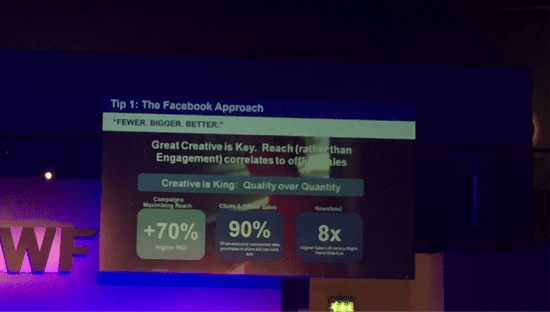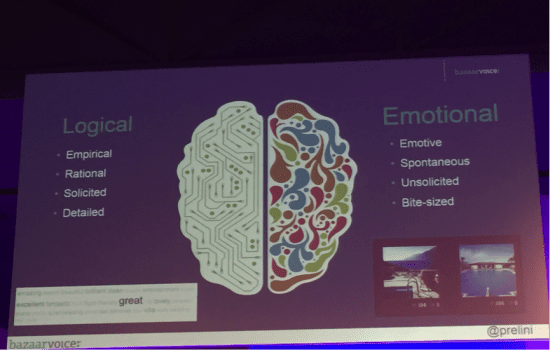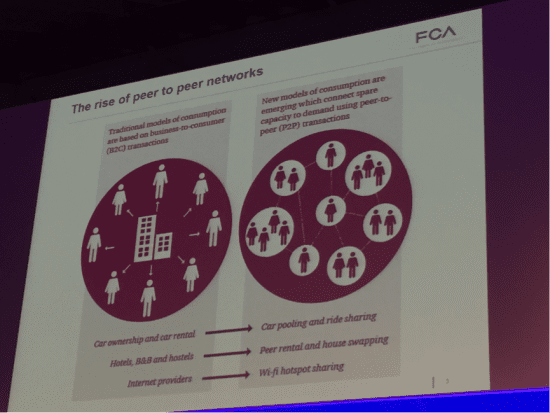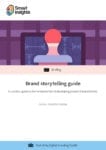Day 1 round-up from Social Media World Forum, June 2015, London
I had the pleasure of attending Day 1 of the Social Media World Forum in London on the 8th June. As you'd expect from an event like this, there was a lot of great stories, insights and new information from the world of social media on topics ranging from humanising your brand and content through to UGC, CGC and online reviews.
Instead of producing a round-up of the individual sessions I attended at #SMWF, I thought it better instead to highlight some of the key themes and trends I took from the event. From day 1 alone I picked up on a number of recurring topics, with the top five including:
- Paid amplification vs. organic growth
- Reviews, user-generated content (UGC) and community
- Rational vs. emotional thinking
- Disrupted business models
- The power of brand storytelling
1. Paid amplification vs. organic growth
It's been long documented that organic reach on many social channels is in decline. (most famously Facebook, which has seen a decline of 12% to 6% over the last few years, and now often at 1% for some pages). So brands are beginning to face the stark reality that they will need to 'pay to play' to reach their target audiences within the social space.
Simon Veaney, Director of Social Media Communications at American Express, advised that in order to succeed in today's modern social media world we should focus on producing less content, but what we do produce should be remarkable and amplified to a wider audience. Simon then provided a set considerations to help brands balance their paid vs. organic approach to social media:
- Picasso's Bull - Apple uses Picasso’s Bull to teach minimalist design principles as part of its Apple University programme and Simon explained how this relates to us. By understanding how a piece of content is constructed (from the bear essentials to the finished article), we can tailor content by channel to maximise effectiveness. For example, a three minute clip might work on YouTube for desktop consumption but a 90 or even 30 second version is required for mobile where screen sizes are smaller and internet connection often weaker
- Blogger outreach - American Express works with bloggers who have genuine credibility and can use their influence to reach niche audiences. However, the influencers must choose you - there has to be a match between blogger and brand
- Use the Twitter approach - Twitter often talks about "planning your spontaneous moments", i.e. plan in advance the type of events relevant to your brand and how you can create content around the things that people are engaged with ‘in the moment’ (think World Cup, Oscars, Glastonbury etc)
- Consider sequential messaging - avoid the ‘matching luggage’ approach to content creation. You don’t need content to match across all channels or to cram everything into one message - consider a series of posts that tell a story or message over time.

2. Reviews, user-generated content (UGC) and building a community
Whilst there was a breakout session focusing specifically on this subject, this was also a theme I noticed in a number of sessions and something that was clearly resonating with the speakers and panel members.
The importance of using UGC to build community and engagement shouldn't be underestimated. If we look at Apple, for example, they have built a powerful army of brand advocates over time whilst Adidas have researched how people are using their products by asking them for direct feedback online.
Online reviews, built into ecommerce sites, can also offer a lot of value by enhancing the customer journey and ultimately increasing conversion rate. There are inherent risks in enabling consumers to review your products online but there are also considerable benefits if the right philosophy is adopted. Thomas Cook, for example, offers reviews as well as photos and Q&As, all of which helps reduce fears and anxiety before booking a trip to a new destination.
Some of the key takeaways I picked up regarding this topic included:
- Authenticity is key. Whilst incentives can work to drive reviews and UGC, they can also be harmful if the community believes good reviews have been 'bought' rather than earned
- Consider how UGC can be built into multiple marketing platforms, both online and offline (e.g. social media channels, banners, packaging etc)
- Use UGC to make product/ service improvements. Is there recurring feedback relating to specific features that can be improved?
- For online reviews, set out your success measures up front. InterContinental Hotels Group (IHG) used the following:
- Quantity (number of reviews)
- Authenticity (genuine customers)
- Conversation (hotel -> guest interaction)
- Get executive buy-in. Building reviews and UGC into a website is a big undertaking for many brands to executive level support is crucial.
3. Rational vs. emotional thinking
The concept of left vs. right-brain thinking is not new but how often do brands consider how customers use their brain to make decisions and tailor their messaging and content accordingly?

Customers will often make decisions based logical and/or emotional reasoning and there's an opportunity to create effective content based on these touch-points.
In her excellent presentation on the Consumer Economy in the Digital Age, Prelini Udayan-Chiechi, VP Marketing at Bazaarvoice, talked about how Clinique use evocative imagery within their website to elicit emotion whilst at the same time leverages user-generated reviews to help customers make rational decisions about the right product for them.
4. Disrupted business models
I thought it was interesting to hear a number of speakers throughout the day talk about case studies from the sharing economy.
The prominence of peer-to-peer companies like AirBnB, Uber and Viber is an indication that consumer behaviour and expectations are changing, and as a consequence are affecting the way they interact with brands. As a result, businesses are having to learn to accommodate 'disownership', i.e. consumers, particularly Millennials, are favouring renting rather than owning products and services (think Netflix, Spotify and even mobile phones).
Whilst I don’t necessarily believe that we’re seeing the end of traditional business models, new ones are emerging and are genuinely challenging the status quo. This means that brands must consider how digital disruption in their industry could affect how consumers interact and evolve their business models and approaches accordingly.
5. The power of brand storytelling
While the benefits of effective storytelling is well established, it was still good to hear some interesting case studies as to how brands are using storytelling and storytelling techniques as part of their content marketing and social media strategies.
As part of a panel discussion specifically around this topic, companies including The North Face, Goodyear and Elle UK talked about what storytelling really means in this context and what we can learn from their efforts.
Some of the key takeaways included:
- Storytelling is about engagement and sharing. So to really make this work make an effort to understand your customers (age, demographic, like/ dislikes) and create content that’s relevant to them
- Effective brand stories are often connected to the brand’s core values
- Tailor stories by platform, i.e. online/ offline; Facebook/ Twitter. Each platform and channel will have unique features that resonate with audiences in different ways
- Consider crafting stories as part of an overarching strategy that works across multiple channels. For example, John Lewis’s 2013 ‘The Bear and the Hare’ campaign spanned TV, social media and in-store experiential marketing
- Reconcile structured and unstructured content. Map out content options and identify channels and formats to push to consumers. Look at data from previous campaigns - what's working? What can be optimised?
Download resource – Brand Storytelling Guide
This practical guide will help you understand the fundamentals of creating brand stories. Guides are available for Expert members only
Access the Brand storytelling guide










